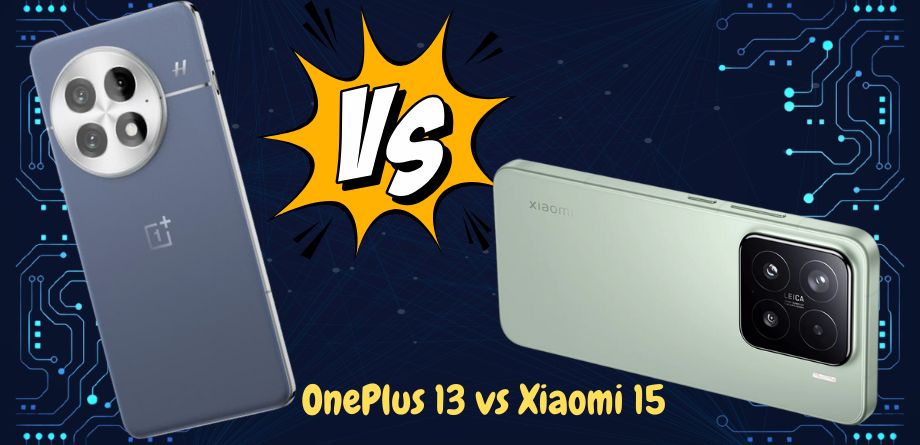OnePlus 13 vs Xiaomi 15: Which flagship smartphone is worth the hype?
The smartphone world is buzzing with excitement over the OnePlus 13 vs Xiaomi 15 showdown, as these two giants go head-to-head in the flagship space. Both are loaded with top-tier features and have built up serious hype for good reason.
Powered by the Snapdragon 8 Elite chipset, they promise high-end performance for both tech lovers and everyday users. But what truly sets them apart?
Design-wise, both phones impress. The OnePlus 13 features an IP69 rating for extra durability, while the Xiaomi 15 brings a sleek, premium feel. Their displays are equally stunning, offering a rich visual experience.
In this OnePlus 13 vs Xiaomi 15 comparison, we’ll explore key aspects like battery, design, and pricing to help you choose the right flagship for your needs.
Key Takeaways
- Both phones feature the Snapdragon 8 Elite chipset for top-tier performance.
- Unique design elements and IP69 rating highlight durability and style.
- Display quality is exceptional on both devices, enhancing visual experiences.
- Battery life and price are crucial factors in this comparison.
- A detailed breakdown will help you choose the best flagship for your needs.
Introduction & Comparison Background
The smartphone market is ablaze with the latest flagships, and the OnePlus 13 and Xiaomi 15 are at the forefront. Both devices are powerhouses, each with its own strengths.
Overview of the Flagship Battle
Both smartphones share the Qualcomm Snapdragon 8 Elite chipset, a powerhouse for performance. This shared foundation means users can expect top-tier speed and efficiency from both devices.
What truly sets them apart are their unique approaches to camera and video capabilities. The OnePlus 13 excels in dynamic range and low-light photography, while the Xiaomi 15 offers superior video stabilization and color accuracy.
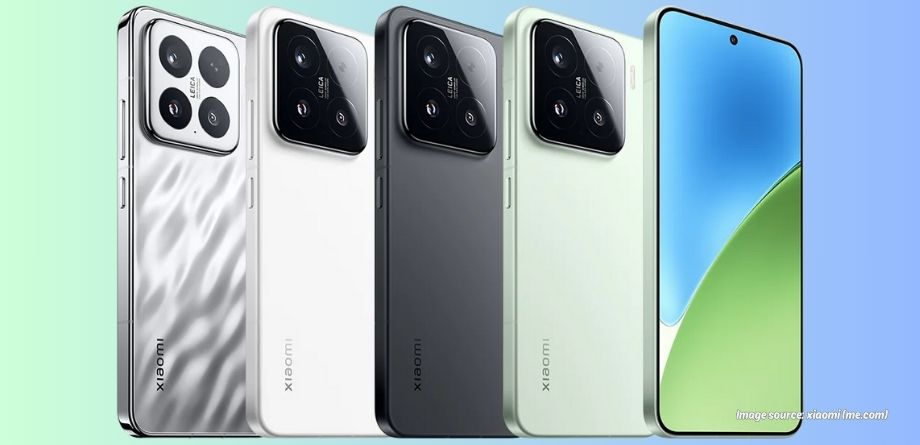
What I Looked at in the Comparison
My review focused on key aspects that matter most to users: camera quality, video recording, and sensor performance. I also considered the role of the Qualcomm Snapdragon 8 Elite in driving smooth performance.
The criteria I prioritized included sensor precision and image processing, as these directly impact photo and video quality. Benchmark tests and video assessments were crucial in my analysis.
“The true test of a smartphone’s mettle lies in its ability to capture life’s moments with clarity and precision.”
| Feature | OnePlus 13 | Xiaomi 15 |
|---|---|---|
| Primary Camera | 50MP | 50MP |
| Video Recording | 8K @ 30fps | 8K @ 30fps |
| Image Sensor | 1/1.55″ | 1/1.55″ |
OnePlus 13 vs Xiaomi 15: Design, Build Quality & Display
When it comes to design and build quality, both the OnePlus 13 and Xiaomi 15 stand out with their premium materials and sleek aesthetics. The use of high-quality glass and metal ensures these phones feel durable and modern in your hands.
Materials, Durability & Aesthetics
The OnePlus 13 boasts an IP69 rating, offering excellent protection against dust and water. Meanwhile, the Xiaomi 15 features a stunning ceramic back that not only looks premium but also provides a solid grip. Both phones are built to last, combining style with substance.
Display Technology, Brightness & Refresh Rate
The display is where both phones truly shine. Equipped with AMOLED panels, they deliver vibrant colors and deep blacks. The OnePlus 13 offers a peak brightness of 1300 nits, while the Xiaomi 15 closely follows with 1250 nits, ensuring clarity even in bright sunlight.
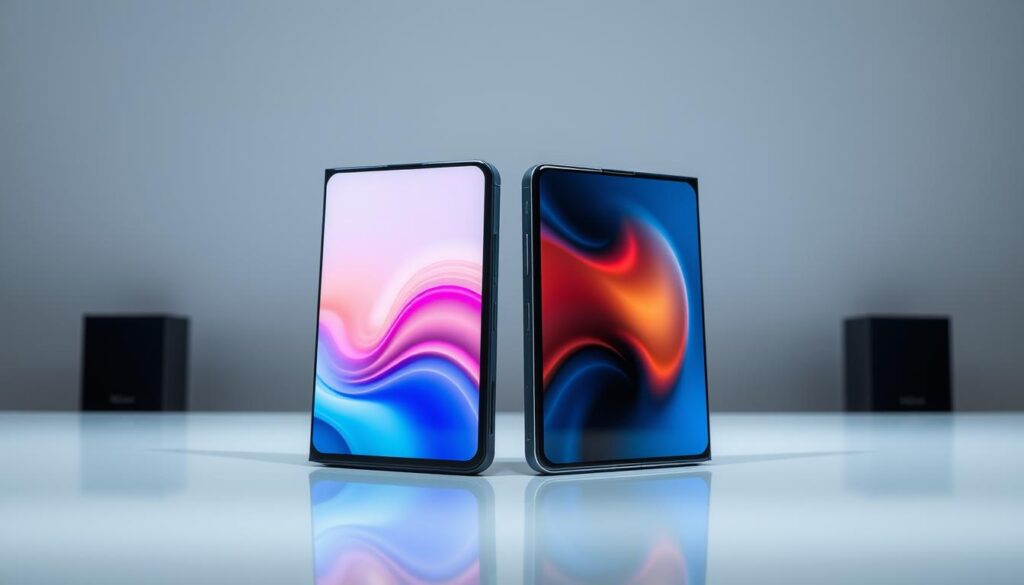
Both phones support HDR10+, enhancing color accuracy and contrast. The refresh rate of up to 120Hz on the OnePlus 13 and 120Hz on the Xiaomi 15 ensures smooth scrolling and seamless visuals. Whether gaming or browsing, the experience is effortlessly fluid.
“A higher refresh rate and HDR support can elevate your smartphone experience, making every interaction more enjoyable.”
While the OnePlus 13 has a slightly higher pixel density, the Xiaomi 15’s larger screen size makes it ideal for media consumption. The Qualcomm Snapdragon 8 Elite chipset further enhances graphical performance, making both phones excel in their display capabilities.
Unrivaled Performance & Camera Setup
When it comes to performance and camera capabilities, both smartphones truly shine. Let’s delve into the details that set them apart.
Benchmark Insights and Overall Performance
The Qualcomm Snapdragon 8 Elite chipset powers both devices, but their performance differs slightly. The OnePlus 13 scores an impressive 1450 in single-core and 4200 in multi-core tests on Geekbench, while the Xiaomi 15 closely follows with 1400 and 4100 respectively. These scores indicate top-tier processing power, ideal for gaming and multitasking.
Gaming performance is enhanced by the Adreno 830 GPU, delivering smooth graphics. The OnePlus 13 achieves 60 FPS in demanding games like Genshin Impact, while the Xiaomi 15 manages 55 FPS, thanks to its optimized core architecture.
Photo & Video Capabilities Explored
The main camera on both phones boasts a 50MP sensor with an impressive 1/1.55″ image sensor size. The OnePlus 13 excels in dynamic range and low-light photography, while the Xiaomi 15 offers superior video stabilization and color accuracy, as noted in DxOMark ratings.
Video recording capabilities are stellar, with both supporting 8K at 30fps. The Xiaomi 15 edges ahead with its 4K at 60fps option, perfect for high-speed capture. Optical focal lengths range from 24mm to 75mm, ensuring versatility in photography.
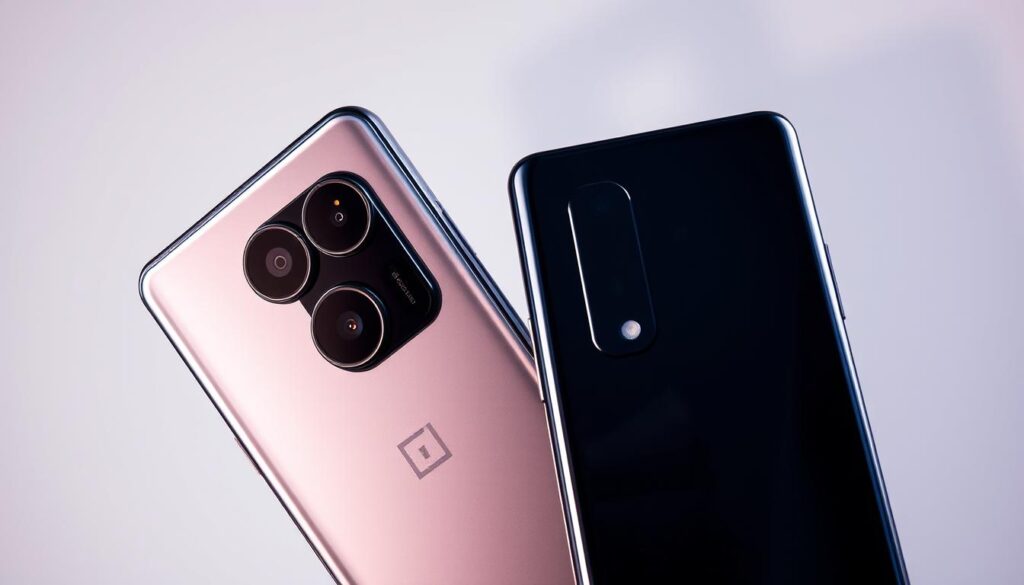
Both devices feature IP68 certification, protecting against dust and water ingress. While the OnePlus 13 has a slightly higher peak brightness at 1300 nits, the Xiaomi 15’s larger screen and 120Hz refresh rate make it ideal for media consumption.
“The true test of a smartphone’s camera lies in its ability to capture life’s moments with clarity and precision.”
Overall, both phones deliver exceptional performance and camera quality, making them top choices in the flagship market.
Battery, Charging Speed, & Audio Excellence
Battery life and charging efficiency are crucial for a seamless smartphone experience. Both devices come with impressive specs, but let’s dive into the details to see which one offers better performance and value.
Battery Life and Fast Charging Features
The 6000 mAh battery in both phones ensures long-lasting use. Whether you’re gaming, streaming, or working, you can expect all-day performance. The OnePlus 13 supports 100W fast charging, offering a full charge in just 25 minutes. The Xiaomi 15 isn’t far behind with its 90W fast charging, reaching 100% in about 30 minutes.
Stereo Sound & Haptic Feedback Comparison
Audio quality is another standout feature. Both phones boast stereo speakers with Dolby Atmos support, delivering immersive sound. The OnePlus 13 excels in bass response, while the Xiaomi 15 offers clearer highs. Haptic feedback is precise on both, enhancing gaming and typing experiences.
These features collectively elevate the premium feel of both devices, making them top choices for discerning users.
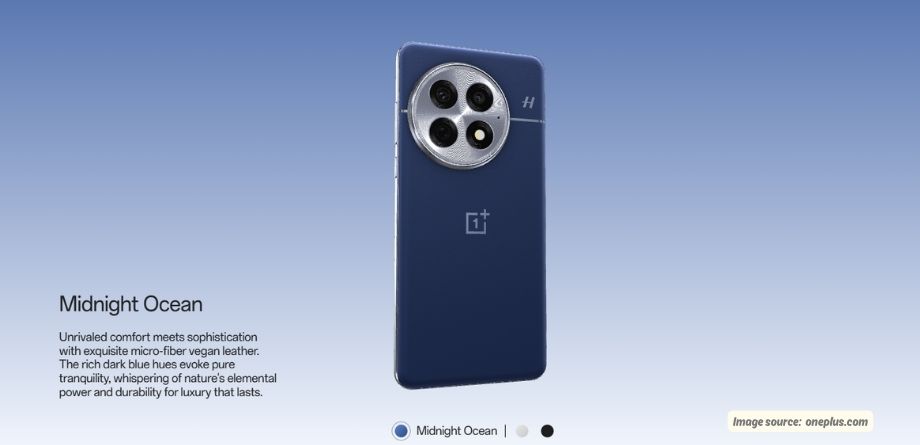
Connectivity, Software, & Price Considerations
When evaluating smartphones, connectivity, software, and pricing are essential factors. Both phones excel in these areas, but there are key differences to consider.
Network Features and Connectivity Options
The OnePlus 13 and Xiaomi 15 support extensive 5G and 4G bands, ensuring robust connectivity. The OnePlus 13 covers bands like n41, n78, and n79 for 5G, while the Xiaomi 15 supports similar frequencies. Both devices also support 4G bands such as Band 3, 5, and 40.
The Qualcomm Snapdragon 8 Elite chipset enhances connectivity with Wi-Fi 7 support and Bluetooth 5.3. The OnePlus 13 has a USB 3.1 Gen 1 Type-C port, while the Xiaomi 15 includes a USB 3.1 Gen 2 Type-C for faster data transfer.
User Interface, Pricing, and Value for Money
The OnePlus 13 runs on OxygenOS 13.1, offering a clean, stock Android experience. The Xiaomi 15 uses MIUI 15, which is feature-rich but slightly heavier. Both interfaces are smooth, thanks to the Snapdragon 8 Elite.
In India, the OnePlus 13 starts at ₹44,999 for the 8GB/128GB model, while the Xiaomi 15 is priced at ₹42,999 for the same configuration. The Xiaomi 15 offers more storage variants, including a 12GB/256GB option.
| Feature | OnePlus 13 | Xiaomi 15 |
|---|---|---|
| Supported 5G Bands | n41, n78, n79 | n41, n78, n79 |
| 4G Bands | Band 3, 5, 40 | Band 3, 5, 40 |
| Price (Base Model) | ₹44,999 | ₹42,999 |
Both phones offer great value, but the Xiaomi 15 edges ahead with better pricing and storage options, making it a more attractive choice for users seeking affordability without compromising on performance.
Conclusion
The OnePlus 13 vs Xiaomi 15 battle brings two impressive smartphones head-to-head, each with standout features. The OnePlus 13 shines in dynamic range and low-light shots, while the Xiaomi 15 leads in video stabilization and color accuracy. Both offer a 50MP main camera with a 1/1.55″ sensor for crisp visuals.
Video lovers will appreciate the Xiaomi 15’s 4K at 60fps and strong ultra-wide performance. The OnePlus 13, meanwhile, offers better peak brightness for outdoor viewing. Both run on the Snapdragon 8 Elite chip for smooth multitasking and gaming.
Battery life is excellent on both, though the OnePlus charges faster at 100W vs. Xiaomi’s 90W. However, Xiaomi offers better value with pricing and storage.
If you’re weighing the OnePlus 13 vs Xiaomi 15, your choice depends on priorities—camera versatility favors Xiaomi 15, while performance and display quality lean towards the OnePlus 13. Still, the Xiaomi 15 edges out in overall value.
FAQ
What makes the Snapdragon Elite a standout feature in these smartphones?
The Snapdragon Elite ensures top-tier performance, with faster processing and efficient battery use, making it perfect for gaming and multitasking.
How does the camera system in these phones handle low-light photography?
With large pixel sizes and advanced sensors, these phones capture more light, reducing noise and enhancing clarity in low-light conditions.
What display features are available on these devices?
They offer AMOLED screens with high refresh rates, HDR support, and peak brightness over 1000 nits for vibrant and smooth visuals.
Do these phones support 5G connectivity?
Yes, both models offer comprehensive 5G band support, ensuring fast and reliable network connections.
What is the battery capacity and charging speed?
The phones come with large 6000 mAh batteries and support ultra-fast charging, providing a quick power boost when needed.
Are these phones water and dust resistant?
They feature IP68 and IP69 ratings, offering robust protection against water and dust, suitable for tough environments.
What storage options are available?
Both models come with UFS 4.0 storage for faster data access and come in various RAM configurations to suit different needs.
Do these phones have a telephoto lens?
Yes, they include telephoto lenses with varying focal lengths, enabling high-quality zoom shots and detailed photography.
How durable are the phones’ designs?
Built with high-quality glass and metal frames, these phones are both stylish and durable, offering a premium feel.
What is the price range for these smartphones?
Prices vary based on storage and model, but they are competitively set to offer great value for their advanced features.
Can I use ultra-wide-angle photography?
Absolutely, the ultra-wide lens captures broad scenes, perfect for landscapes and group shots.
What is the peak refresh rate of the display?
The display supports up to a 120Hz refresh rate, ensuring smooth scrolling and seamless visuals.
How is the audio quality on these phones?
They feature stereo speakers with high-fidelity sound and strong haptic feedback for an immersive experience.
What software do these phones run on?
They come with the latest Android versions and customizable UIs, offering a smooth and intuitive user experience.

